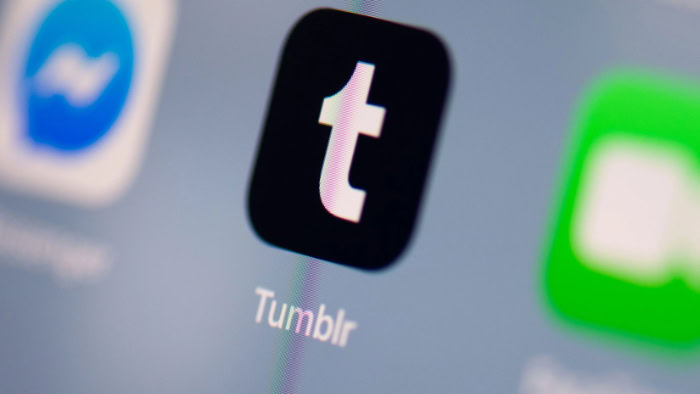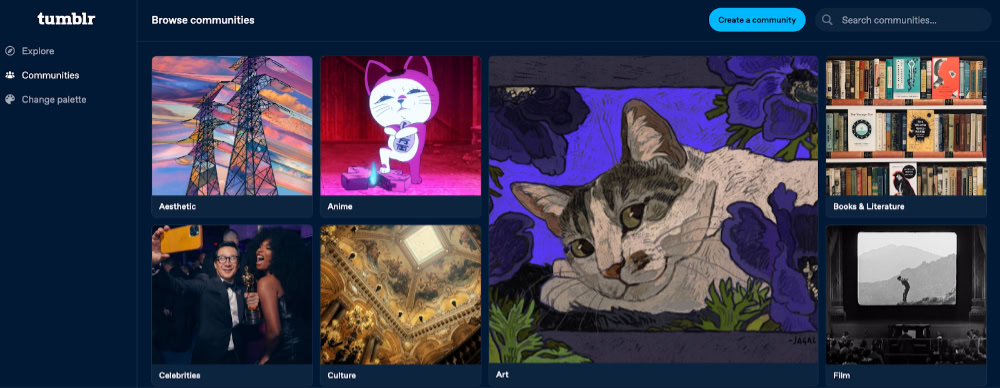What Is Tumblr? Beyond The Feed

Tumblr stands apart as a hybrid platform that blends microblogging with social networking. It functions as a space where users share short-form multimedia posts on fully customizable blogs.
People often ask about its specific purpose because it operates differently from rigid social feeds found elsewhere. You might want to know how the site works or if it suits your creative or business requirements.
What Tumblr Is
Tumblr occupies a unique position in the online ecosystem by bridging the gap between a standard website builder and a social media feed. It does not force users to choose between publishing content and interacting with a community.
The platform merges these two concepts into a single, fluid experience. You can think of it as a space where the customizable nature of a personal website meets the connectivity of a social network.
A Hybrid of Microblogging and Social Networking
The platform defines itself through the concept of microblogging. This term refers to the practice of posting short, frequent updates rather than long, formal articles.
Users post multimedia content including text, photos, quotes, links, music, and videos to their personal “tumblelog.” While a traditional blog might update once a week with a thousand words, a Tumblr blog might update ten times a day with single images or short thoughts.
Social mechanics drive the distribution of this content. The dashboard serves as the central hub where you see posts from every blog you follow.
Users interact through likes and replies, but the reblog function acts as the primary engine of the site. Reblogging allows a user to take a post from someone else and republish it to their own blog, often adding their own commentary.
This creates a long chain of conversation and content sharing that moves rapidly across the user base.
A Brief History and Current Ownership
David Karp founded Tumblr in 2007. The site quickly attracted a dedicated following of artists, writers, and young people who wanted a free and easy place to express themselves.
It grew rapidly during the early 2010s and defined much of the internet culture of that era.
The ownership history reflects the turbulent nature of the tech industry. Yahoo acquired the platform in 2013 for a massive sum, followed by an acquisition by Verizon.
In 2019, the platform found a more stable home with Automattic, the parent company behind WordPress.com. While it no longer commands the massive headlines it did a decade ago, Tumblr remains a significant cultural force.
It operates as a niche but highly influential platform where trends often originate before spreading to larger networks.
Distinct Differences from Other Platforms
It helps to view Tumblr in contrast to its competitors to truly grasp its identity. Traditional blogging platforms like WordPress or Blogger often feel static and solitary.
They prioritize structure and SEO, while Tumblr prioritizes speed and community interaction. You do not need to worry about formatting complex layouts or managing plugins just to share a photo.
Tumblr also differs sharply from mainstream social networks like Facebook, Instagram, or TikTok. Those platforms generally rely on aggressive algorithms to determine what you see.
They also tend to emphasize your real-world identity and personal connections. Tumblr takes the opposite approach.
It typically shows posts in reverse chronological order, meaning you see the newest content first without algorithmic interference. Furthermore, the culture encourages pseudonymity. Users connect based on shared interests and aesthetics rather than who they went to high school with or who they work with.
How Tumblr Works

The mechanics of Tumblr are straightforward once you familiarize yourself with the layout, yet they offer enough depth to support complex content strategies. The platform operates on a structure that encourages users to curate their own space while constantly interacting with others.
Managing Accounts and Blogs
Getting started involves creating a single account which automatically establishes your “Primary” blog. This blog serves as your main identity on the platform.
It allows you to follow other users, like posts, and send messages. Your primary blog is the public face of your activity, and it is the only blog attached to your social interactions within the ecosystem.
A distinct feature of Tumblr is the ability to create “Secondary” blogs under the same account. You can create multiple additional blogs to organize different interests without needing new login credentials.
For example, a user might keep their primary blog for general personal updates while maintaining separate secondary blogs for photography, poetry, or specific fan interests. Secondary blogs allow for multiple contributors, making them ideal for collaborative projects or group themes, though they lack some of the social capabilities of the primary blog, such as liking posts directly.
The Dashboard and Feed Experience
The dashboard acts as the home screen and the heart of the user experience. When you log in, you see a continuous feed of content from every blog you follow.
Unlike many modern platforms that shuffle posts based on engagement metrics, the Tumblr dashboard generally prioritizes a reverse-chronological order. You see the latest posts from your followed accounts as they happen, which gives you more control over what you consume.
At the top of the dashboard sits the creation bar. Icons representing different post types allow you to quickly draft new content.
Below this bar, the feed allows for three main interactions: liking, reblogging, and replying. Liking a post saves it to your liked interactions and signals appreciation to the creator.
Reblogging is the most significant action, as it takes another user’s post and shares it to your own blog. You can add your own commentary, images, or tags to a reblog, continuing the conversation and spreading the content to your own followers.
Content Formats and Discovery Tools
Tumblr supports seven distinct post types designed to handle specific media. Text posts allow for writing with rich formatting, while Photo posts support high-resolution images and sets of up to ten photos. Specialized formats include Quote posts for highlighting text, Link posts for sharing external URLs, Chat posts for dialogue scripts, Audio posts for music or podcasts, and Video posts.
This variety ensures that users can choose the exact format that suits their message without forcing content into a generic box.
Finding content outside of your immediate circle relies heavily on the tagging system. Users add tags (preceded by the # symbol) to their posts to categorize them.
You can search for these tags to find posts about specific topics, from “vintage fashion” to “video games.” The platform also features an Explore tab and a “Trending” section which surface popular posts and growing communities. These tools help you find new blogs to follow, ensuring your dashboard remains active even if your current connections are quiet.
Culture, Communities, and Common Uses
Tumblr is defined less by its software features and more by the distinct groups that inhabit it. The platform serves as a gathering place for diverse interests where users can find deep connection over specific topics.
Unlike broad social networks that cast a wide net to capture everyone, this site acts as a collection of tight-knit circles where enthusiasm and creativity drive the conversation.
Fandoms and Subcultures
Fandoms act as the primary engine of activity on the site. Passionate communities form around television shows, movies, video games, bands, and books to create a shared space for discussion and celebration.
Within these spaces, fans do not just consume content; they actively participate in it by adding their own contributions. Users publish detailed theories about plotlines, share original fan fiction, and circulate fan art that often rivals professional work in quality.
Memes also flourish here, often developing a specific, surreal sense of humor that can be difficult for outsiders to decipher. These subcultures provide a strong sense of belonging for people who might feel isolated in their offline lives.
The platform offers a space where intense enthusiasm is celebrated rather than judged, allowing specific interests to grow into complex, self-sustaining cultures.
Personal Expression and Aesthetics
Many users treat their blog as a digital canvas for personal curation. “Aesthetic” blogs function as carefully managed moodboards, collecting images that follow a specific color palette, atmosphere, or visual theme.
These blogs might focus on anything from cottagecore nature imagery to dark academia or cyberpunk cityscapes. The goal is often to capture a feeling or a vibe rather than to communicate specific information.
Beyond visuals, the platform serves as a modern diary for many individuals. Users appreciate the semi-anonymous nature of the site, which allows them to express thoughts without the pressure of real-world peers watching.
This environment makes it a safe harbor for people to examine their identities, discuss mental health, or document their daily lives. The lack of pressure to present a polished, perfect lifestyle allows for a rawer and more authentic form of sharing compared to other image-centric platforms.
Professional Portfolios and Creative Work
Creative professionals utilize the platform to build a portfolio that feels alive and interactive. Illustrators, writers, and photographers find immense value in the way content spreads through the reblog mechanism.
A single piece of art can be shared thousands of times, carrying the artist’s name to corners of the internet they might never reach otherwise.
Unlike static portfolio websites, a Tumblr blog allows creators to show their process, answer questions from admirers, and build a loyal following. It acts as a low-barrier gallery where work can be tested and appreciated in real-time.
This direct line to an audience helps independent creators sell merchandise, take commissions, and establish a brand voice that feels personal. The ability to mix professional work with casual updates helps creators humanize their brand and deepen the connection with their supporters.
Benefits and Advantages

Tumblr offers a distinct set of tools that separates it from the crowded field of social networking apps. The platform solves specific problems for users who feel restricted by the rigid layouts and algorithmic feeds found elsewhere.
It attracts individuals and organizations looking for a balance between creative freedom and community connection.
Creative Flexibility and Customization
The primary appeal for many users lies in the unprecedented control over visual presentation. Most social networks force every profile to look identical, but Tumblr encourages you to break the mold.
You can install custom themes that completely alter the layout, typography, and color scheme of your blog. Users with coding knowledge can even edit the HTML and CSS directly to create a truly unique web presence.
This level of customization makes the platform feel more like a personal website than a borrowed profile page.
Content creation also benefits from a lack of friction. The interface supports seven different post types, allowing you to switch seamlessly between writing long essays, sharing audio tracks, or posting high-resolution photo sets.
There is no pressure to maintain a consistent format. You can post a polished video one minute and a quick text update the next. This versatility removes the mental block often associated with content creation, making it easy to post whatever feels right in the moment.
Organic Reach and Community Growth
Content travels on Tumblr in a way that differs significantly from other major platforms. The reblog mechanism allows a post to circulate through the ecosystem for months or even years.
A post does not die once it leaves the top of a feed; it continues to gain traction as users discover and share it with their own followers. This creates a long tail of engagement where quality content remains relevant long after the original publish date.
Discovery relies heavily on an effective tagging system rather than complex algorithms. When you tag a post correctly, it enters a global stream that anyone interested in that topic can view.
This gives new accounts a fair chance to be seen immediately. You do not need an existing audience to get engagement; you simply need to contribute to the topics people are already browsing.
Niche communities are highly active, meaning that specialized content often finds a dedicated audience faster than it would on broader, general-interest networks.
Branding and Storytelling Opportunities
Brands and businesses utilize Tumblr to establish a distinct voice and visual identity. The platform serves as an excellent venue for storytelling and “soft marketing,” where the goal is to build an atmosphere rather than push for immediate sales.
Companies can curate mood boards or share behind-the-scenes content that humanizes their organization. This approach helps build loyalty by treating customers as part of a community rather than just targets for advertising.
It also functions effectively as a supporting player in a wider marketing strategy. While you might use other platforms for announcements or customer service, Tumblr can act as the home for your brand’s culture and aesthetic.
It allows for a deeper level of expression that complements more direct marketing channels. The ability to combine text, visuals, and audio in a single stream helps brands construct a complete narrative that resonates with a younger, culturally aware demographic.
Risks, Limitations, and Safety Considerations
Tumblr operates with a high degree of freedom, but that open environment introduces specific challenges that every user should recognize. The platform differs significantly from more regulated social networks in how it handles content and user interactions.
Content and Safety Concerns
The platform has a complex history regarding mature content. While current policies ban explicit material, the site remains a haven for unrestricted artistic expression and discussions on sensitive topics.
Users frequently discuss mental health, politics, and identity in ways that can be raw and unfiltered. The community often uses “Trigger Warnings” or “TW” tags to flag difficult subjects, but this system relies entirely on user goodwill rather than software enforcement.
You might encounter content that feels darker or more intense than what is typically found on mainstream feeds. The “Safe Mode” filter helps screen out sensitive media, yet it is not a perfect shield against every type of controversial material.
Text-based discussions, in particular, can bypass visual filters. Users need to be prepared to curate their own experience by actively unfollowing blogs or blocking tags that bring unwanted negativity into their feed.
Platform Limitations for Growth
The site does not serve every purpose equally well. If your goal is to connect with family members, colleagues, or a massive general audience, you will likely find the platform lacking.
The user base is significantly smaller and more insular than giants like Instagram or TikTok. Content that goes viral here often stays within the ecosystem rather than breaking out to the wider web.
The culture values anonymity and pseudonymity, which makes it a poor choice for traditional professional networking. Real-name usage is rare.
This environment creates a barrier for individuals trying to build a personal brand linked to their legal identity. Furthermore, the advertising tools are less sophisticated than those offered by competitors, making it harder for brands to target specific demographics with precision.
Guidance for Safer Use
Staying safe involves actively managing your account settings. The platform provides robust tools for blocking specific users and filtering out words or tags you wish to avoid.
For example, if you do not want to see posts about a specific TV show or a triggering topic, you can add those terms to your filter list to remove them from your dashboard entirely.
Privacy options allow for further control. You can choose to hide your blog from search engine results or prevent people from finding you via email.
For parents, it is important to note that the site is generally geared toward older teens and young adults. The creative freedom here is vast, so relying solely on technical restrictions is often insufficient.
Open conversations about internet safety and how to use the blocking tools are usually the most effective way to ensure a positive experience.
Conclusion
Tumblr remains a singular entity in the social media market by effectively blending the personal touch of blogging with the connectivity of a network. It offers a highly customizable environment where users can build a space that truly reflects their interests rather than just filling a standardized profile.
The platform primarily benefits creative individuals and passionate communities who value expression over algorithmic validation.
Fandoms and artists thrive here because the tools support organic sharing and deep engagement. Success on the site requires a willingness to adapt to its specific norms and an awareness of its open nature.
If you are looking for a place to pursue niche interests or showcase work without the pressure of mainstream performance metrics, this platform offers a compelling alternative.


